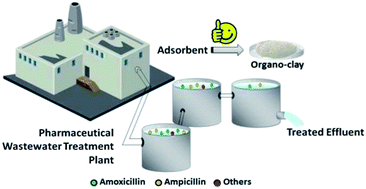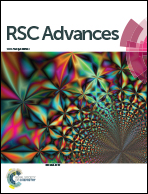Antibiotic detoxification from synthetic and real effluents using a novel MTAB surfactant-montmorillonite (organoclay) sorbent†
Abstract
The growing threat of antibiotic-resistant bacteria to public health has raised interest in the proper treatment of discharged pharmaceutical wastewater before entering surface waters. In this study, adsorption was highlighted as a low cost and effective pathway to remove amoxicillin and ampicillin from aqueous solutions. Montmorillonite (Na-MMT) and myristyltrimethylammonium (MTA)-intercalated montmorillonite (O-MMT) were employed as the adsorbing solids. Static adsorption experiments were performed at three temperatures (303.15 K, 313.15 K and 323.15 K) for single antibiotic systems. The adsorption isotherm curves at all temperatures exhibited an L2-type isotherm. The Freundlich and Langmuir models were applied to analyze single adsorption isotherm data. The maximum sorption capacity of 0.124–0.133 mmol g−1 for amoxicillin and 0.143–0.157 mmol g−1 for ampicillin was estimated for O-MMT sorbent from Langmuir fitting. A modified extended-Langmuir model with the inclusion of surface coverage (θ) was proposed for analysis of binary adsorption isotherm data. The fitness of the modified extended-Langmuir model was superior to the original model. Batch adsorption tests on real pharmaceutical wastewater demonstrated the feasibility of the O-MMT sorbent for practical applications.


 Please wait while we load your content...
Please wait while we load your content...